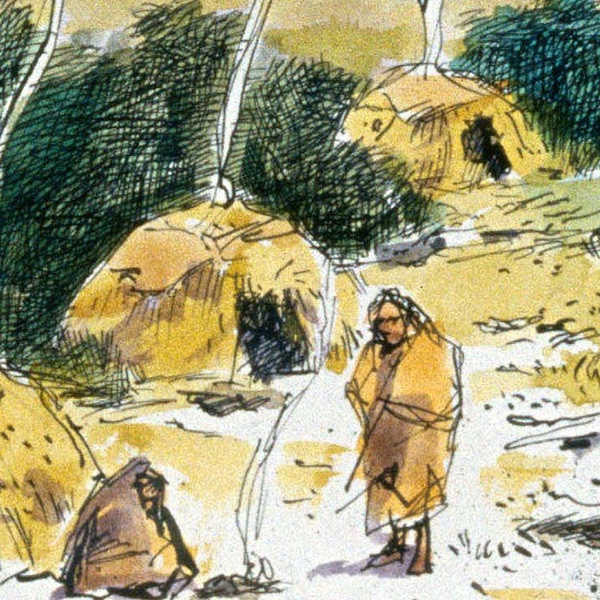Graham-Applegate: Making Inferences about a Llano River Rancheria

Download lesson plan and included materials
Subject: Social Studies
Grade:4th and 7th
Author: Jason Terry (2001), revised by Jason Terry (2023)
Time Duration: Two 45-minute class periods or one 90-minute block period
Objective: Students will learn about native groups who lived 1,000 years ago on the Llano River. The students will use paintings and images of tools and artifacts to make inferences and conclusions about how the Indians lived. Then, in groups, the students will teach the rest of the class about one aspect of the groups' archeological history.
TEKS: Social Studies, Grade 4
- (1) History. The student understands the origins, similarities, and differences of American Indian groups in Texas before European exploration. The student is expected to:
- (1A), explain the possible origins of American Indian groups in Texas;
- (1B), identify and compare the ways of life of American Indian groups in Texas before European exploration such as the Lipan Apache, Karankawa, Caddo, and Jumano
- (1C), describe the cultural regions in which American Indians lived such as Gulf, Plains, Puebloan, and Southeastern
- (19A), differentiate between, locate, and use valid primary and secondary sources such as technology; interviews; biographies; oral, print, and visual material; documents; and artifacts to acquire information about Texas
- (21A), use social studies terminology correctly
- (21C), express ideas orally based on research and experiences
- (21D), create written and visual material such as journal entries, reports, graphic organizers, outlines, and bibliographies
Social Studies, Grade 7
- (1A), identify the major eras in Texas history, describe their defining characteristics, and explain the purpose of dividing the past into eras, including Natural Texas and its People
- (2A), compare the cultures of American Indians in Texas prior to European colonization such as Gulf, Plains, Puebloan, and Southeastern
- (20A), differentiate between, locate, and use valid primary and secondary sources such as media and news services, biographies, interviews, and artifacts to acquire information about Texas
- (20B), analyze information by applying absolute and relative chronology through sequencing, categorizing, identifying cause-and-effect relationships, comparing, contrasting, finding the main idea, summarizing, making generalizations and predictions, and drawing inferences and conclusions
- (22A), use social studies terminology correctly
- (22C), create written, oral, and visual presentations of social studies information
Materials:
- "A Rancheria" illustration (included)
- "Graham-Applegate Introduction" image (included)
- Artifact placards (included). Each of the following artifacts have a separate picture page and an information page: Dart Points, Manos, Micro Cores, Exotic Volcanic Glass, Burned Rock Midden
- Artifact Information Answer Key (included)
- Writing and illustration materials
- Internet (optional)
Activities and Procedures:
Step 1: Display the "Graham-Applegate Introduction" image. Read the introduction to the class, framing it as a mystery. Explain that it will be their job to learn as much as possible about this elusive culture's lifestyle based on artifacts found at the Graham-Applegate site.
Step 2: Display "A Rancheria" illustration. Explain that rancheria was the Spanish name for a temporary settlement inhabited by Native Americans. The students will search the illustration for details that give clues as to the pictured Indians' way of life. The students may point out clues from their desk or come up to the screen to identify them. As clues are identified, the teacher will lead the class in a discussion about the natives, covering such points as:
- Do the inhabitants appear to be nomadic or settled?
- What types of foods do they appear to eat?
- What types of jobs were there to be performed around the village?
Step 3: Divide the class into groups of 4-5. Give each one a different placard with a picture of an artifact on it. Explain that each picture illustrates an artifact found at the Graham-Applegate site. It is the group's task to figure out what their object was used for. Each group should appoint a recorder to keep track of ideas as the group brainstorms.
Step 4: Allow time for each group to brainstorm, while monitoring their progress. If groups are still stumped after the allotted time has expired, the teacher may provide clues as to the artifact's identity and purpose, using the Artifact Information Answer Key.
Step 5: After the students have learned the identity and purpose of their artifact, the teacher will give each group a handout containing more information on their artifact. Students should read the handout together and discuss the questions.
Step 6: Each group should then come up with a format to teach the class about their artifact. It can be a skit or other presentation. Encourage students to use the following websites to learn more about their artifacts.
Step 7: Allow the groups to present their artifact to the class.
Student Product:
- Artifact brainstorming notes
- Descriptive paragraphs of the Graham-Applegate site
- Group role play or poster presentation of each group's artifact
Closure: Display the Introduction image again. Have the students discuss which of their initial predictions were accurate, and what new, improved conclusions may be made.
Assessment: Have the students write a paragraph about the Graham-Applegate rancheria. The paragraph should describe the lifestyle of the Indians who once lived at the site. Each paragraph should include the following words used correctly: rancheria, ear, chert or flint, granite, and cook.